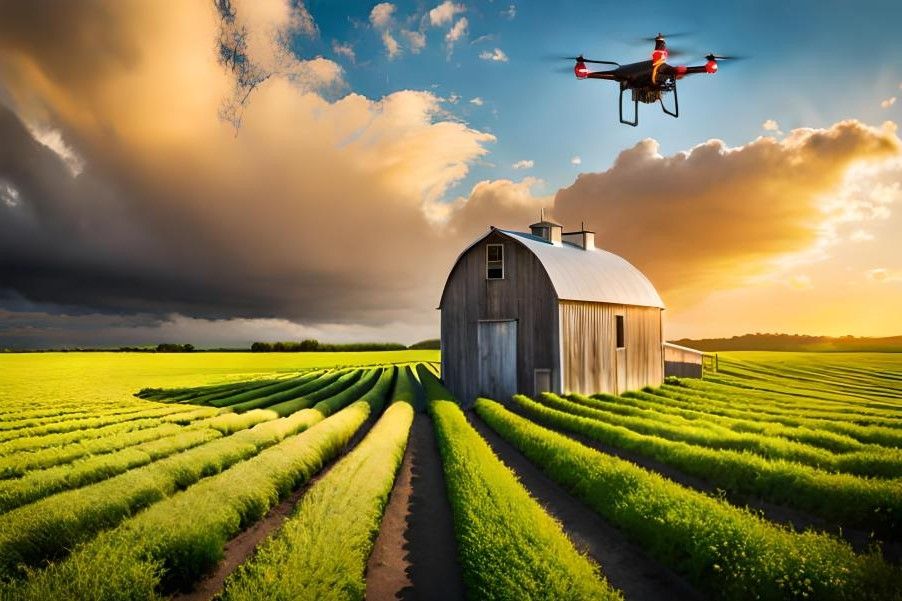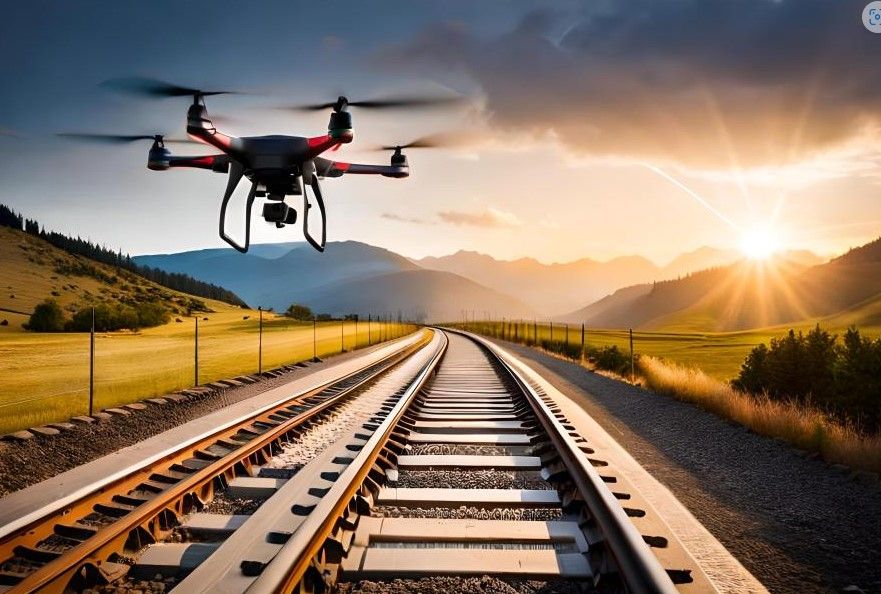"Revolutionizing Industries: The Future of Business with Drone Technology"

"Explore the transformative power of drone technology as it revolutionizes industries. Discover how drones are reshaping businesses, enhancing efficiency, and opening up new opportunities for growth. Learn about their applications in construction, agriculture, and more in this insightful blog post."
*This blog provides educational and informational content only and should not be considered financial advice. The information presented is based on research and personal experiences, but readers should conduct their own research and seek professional advice before making any financial decisions. The blog and its author are not liable for any losses or damages resulting from reliance on the information provided. Readers are responsible for their own financial decisions and should exercise caution and diligence when interpreting and applying the information shared.*
Disclaimer: This blog may contain affiliate links within the posts. These links allow us to earn a small commission from any purchases made through them, which helps support the blog and its content. Rest assured that we only recommend products or services that we genuinely believe in and have personally used or researched. Your trust is important to us, and we are committed to providing valuable and unbiased information. Thank you for your support.
1. Introduction
Drones have transcended their origins as mere hobbyist gadgets and emerged as powerful game-changers across a multitude of industries. Today, their impact can be witnessed in sectors as diverse as agriculture, construction, and delivery services. These unmanned aerial vehicles (UAVs) are revolutionizing the way businesses operate, offering a wide range of benefits that improve efficiency and productivity while reducing costs.

2. How drones are shaping the future of business
As the technology and capabilities of drones continue to advance, they are transforming various industries and paving the way for a new era of business. Discover the key ways in which drones are reshaping the future of the business landscape.
1. Enhancing Efficiency and Productivity: Drones are transforming industries like agriculture, construction, and logistics by streamlining operations and boosting productivity. With their ability to automate manual tasks, these unmanned aerial vehicles (UAVs) offer quick and precise data collection, crop monitoring, infrastructure inspections, and even package delivery. By minimizing human involvement, drones save valuable time and resources while optimizing efficiency in these sectors. Discover the remarkable impact of drones on agriculture, construction, and logistics and unlock new possibilities for your business.
2. Improving Safety: Drones are becoming invaluable tools for industries that involve hazardous or high-risk environments. In sectors like oil and gas, drones can conduct inspections of hard-to-reach areas, reducing the need for workers to perform dangerous tasks. This not only improves safety but also minimizes the potential for accidents and injuries.
3. Providing Aerial Insights: With their ability to capture high-resolution aerial footage, drones are transforming industries such as real estate, film and entertainment, and surveying. They offer a unique perspective that was previously only possible with costly manned aircraft or helicopters. Drones provide detailed views of properties, construction sites, and landscapes, enabling businesses to make more informed decisions and showcase their assets in a visually appealing way.
4. Enabling Innovative Applications: Drones have emerged as game-changers, bringing innovative applications to diverse industries. This article explores their impact on agriculture and delivery sectors, revolutionizing practices and opening up new possibilities.
5. Reducing Costs: Drones offer cost-effective solutions for businesses. Compared to traditional methods, such as manned aircraft or ground-based inspections, drones require less manpower and resources. They can cover larger areas in less time, reducing operational costs. Additionally, the data collected by drones can be analyzed and utilized for predictive maintenance, enabling businesses to identify and address issues before they become major problems, resulting in significant cost savings.
The future of business is closely tied to the evolution and integration of drone technology. As regulations continue to evolve and the capabilities of drones expand, industries will find new ways to leverage this technology to gain a competitive edge, streamline operations, and drive innovation. Businesses that embrace drones and adapt to the changing landscape will be well-positioned to thrive in the future.

3. Drones
Some types of drones being utilized are the DJI Mini 3 Pro (DJI RC), Ruko GPS Drone, Holy Stone HS720E GPS Drone
When it comes to drones, the market offers a wide range of types and models, each boasting distinct features and capabilities. In this blog post, we will provide an in-depth overview of three highly sought-after drones: the DJI Mini 3 Pro (DJI RC), the Ruko GPS Drone, and the Holy Stone HS720E GPS Drone. Explore the specifications, performance, and unique attributes of these popular drone options to make an informed decision.
The DJI Mini 3 Pro is a compact and lightweight drone that is known for its portability and ease of use. Equipped with a high-quality camera, this drone allows users to capture stunning aerial photos and videos with incredible clarity. It also comes with advanced features such as intelligent flight modes, obstacle detection, and precise hovering, making it suitable for both beginner and experienced pilots. The DJI Mini 3 Pro is designed for recreational use and is an excellent choice for those looking to explore the world of drone photography.

2. Ruko GPS Drone:
The Ruko GPS Drone is a top-notch drone that combines versatility with cutting-edge built-in GPS capabilities. Designed to deliver precise positioning, accurate flight navigation, and customizable flight paths, this drone offers an unmatched experience. Equipped with a high-definition camera, it effortlessly captures crystal-clear aerial footage. Additionally, it boasts advanced flight modes, including the coveted Follow Me mode, enabling autonomous tracking and footage capture of the user. If you're searching for a user-friendly drone with advanced GPS functionality, look no further than the Ruko GPS Drone.

3. Holy Stone HS720E GPS Drone:
The Holy Stone HS720E GPS Drone is a top-of-the-line professional-grade drone that delivers outstanding performance and cutting-edge capabilities. Its exceptional 4K camera ensures breathtaking ultra-high-definition videos and photos, enabling users to capture every intricate detail from an aerial perspective. With intelligent flight modes and precise GPS positioning, the Holy Stone HS720E guarantees unparalleled stability and maneuverability, making it the perfect companion for capturing top-notch aerial footage. Moreover, its impressive flight time and impressive range of up to 4 kilometers grant users the freedom to explore vast distances without limitations. As a reliable and feature-rich drone, the Holy Stone HS720E GPS Drone stands out as the ultimate choice for professional photographers, filmmakers, and passionate drone enthusiasts. Elevate your aerial photography and videography to new heights with this exceptional drone.

Discovering the ideal drone to meet your needs can be an exhilarating journey. While the following three drones offer exceptional features, it's crucial to remember that they represent only a fraction of the vast range available. Each drone boasts its own distinct capabilities, ensuring a tailored experience for every user. When selecting your drone, it's essential to factor in your specific requirements and personal preferences.
Whether you're a novice in search of a user-friendly option or a seasoned professional craving cutting-edge features, rest assured that a drone perfectly suited to your desires awaits. As the realm of drone technology continues to evolve rapidly, brace yourself for a future flooded with even more innovative and advanced models.
Embark on your drone adventure today and witness firsthand the limitless possibilities these remarkable devices can unlock for you. Get ready to soar to new heights and capture awe-inspiring moments like never before!

4. Drones in agriculture: increasing efficiency and productivity
Drones, or unmanned aerial vehicles (UAVs), are rapidly revolutionizing multiple industries, including agriculture. The integration of drone technology in agriculture has unleashed a wealth of possibilities and significantly enhanced efficiency and productivity. In this article, we delve into the transformative impact of drones on the agricultural sector, highlighting their indispensability as a vital tool for farmers and agronomists. Discover the myriad benefits and opportunities that arise from harnessing drones in agriculture.
1. Crop Monitoring and Assessment:
One of the key advantages of drones in agriculture is their ability to provide farmers with valuable real-time information about their crops. Equipped with high-resolution cameras and sensors, drones can capture detailed aerial imagery of the fields, allowing farmers to closely monitor crop health, identify areas of stress or disease, and make informed decisions about irrigation, fertilization, and pest control. By detecting problems early on, farmers can implement targeted interventions and optimize their crop yields.
2. Precision Agriculture:
Drones have enabled the concept of precision agriculture, which refers to the practice of using data-driven approaches to make informed decisions about agricultural management. By collecting data through drones, farmers can create detailed maps of their fields, identifying variations in soil composition, moisture levels, and crop growth. This information can then be used to implement precision farming techniques such as variable rate application of fertilizers and pesticides, optimizing resource allocation and minimizing environmental impact.
3. Crop Spraying:
Traditionally, crop spraying was a labor-intensive and time-consuming task that involved manual labor or the use of large machinery. With drones, farmers can automate and streamline this process, significantly reducing the time, cost, and health risks associated with crop spraying. Drones equipped with specially designed spraying systems can accurately spray crops with precision, ensuring even coverage and minimizing product waste. This targeted approach not only improves the effectiveness of pest and disease control but also reduces the exposure of farmers and workers to potentially harmful chemicals.
4. Livestock Monitoring:
In addition to crop-related applications, drones offer valuable livestock monitoring capabilities. On large-scale farms, drones efficiently cover extensive land areas, enabling real-time aerial surveillance of livestock. This advanced technology aids farmers in promptly identifying potential concerns like escaped animals, injuries or illnesses, and incidents of theft or predation. By swiftly detecting and addressing these issues, farmers can prioritize the well-being and safety of their livestock while enhancing their operational efficiency.
5. Environmental Impact:
Discover the practical advantages of utilizing drones in agriculture, promoting sustainability and environmentally conscious farming practices. By leveraging drones, farmers can effectively reduce the consumption of fertilizers, pesticides, and water by precisely targeting specific areas needing intervention. This targeted approach minimizes waste and runoff, contributing to a greener future. Furthermore, drones offer the ability to monitor and evaluate the environmental impact of agricultural activities, empowering farmers to make informed decisions based on data-driven insights. Embrace responsible land management and conservation practices with the help of drone technology in agriculture.
As technology continues to advance, we can expect to see even more innovative applications of drone technology in agriculture. From advanced sensors and artificial intelligence algorithms to autonomous navigation and data analytics, the future of drones in agriculture holds tremendous potential for further improving efficiency, productivity, and sustainability in the industry. As farmers embrace these technological advancements, the future of agriculture looks promising as we strive to meet the increasing global demand for food in a responsible and efficient manner.

5. Drones in construction: improving safety and reducing costs
Drones, or unmanned aerial vehicles (UAVs), have brought about a revolutionary impact across multiple industries, including construction. Their integration in construction processes has not only introduced novel prospects but also enhanced safety measures and reduced costs significantly. This segment delves into the transformative role of drones in the construction sector, elucidating their indispensability as a tool for construction companies and project managers. Discover the ways in which drone technology is reshaping the construction industry and uncover the reasons behind its growing importance.
1. Site Surveying and Mapping:
One of the key advantages of drones in construction is their ability to quickly and accurately survey construction sites. Uncover the game-changing benefits of utilizing drones equipped with high-resolution cameras and sensors in construction site management. Gain a comprehensive understanding of how these advanced technologies enable project managers to capture detailed aerial imagery, providing an up-to-date and comprehensive view of the construction areas.
2. Safety Inspections:
Safety is a top priority in the construction industry, and drones play a crucial role in improving safety standards. Drones can be deployed to conduct inspections of tall structures, bridges, roofs, and other hard-to-reach areas, eliminating the need for workers to physically climb scaffolding or use equipment such as cranes. This significantly reduces the risk of accidents and injuries, ensuring a safer working environment for construction workers. Additionally, drones can detect potential hazards such as cracks, leaks, or structural damage, allowing for timely repairs and maintenance.
3. Progress Monitoring:
Keeping track of construction progress is essential for timely project completion. Drones enable real-time monitoring of construction sites, providing project managers with accurate and up-to-date information on the status of various stages of construction. This helps identify any deviations from the original plan, allowing for prompt adjustments and corrective actions. By closely monitoring progress, construction companies can ensure that projects are completed on time and within budget, ultimately reducing costs and improving overall project management.
4. 3D Modeling and Building Information Modeling (BIM):
Drones can capture data that can be used to create 3D models of construction sites. This enables construction companies to visualize the project in a virtual environment, making it easier to identify design flaws, make informed decisions, and communicate effectively with stakeholders. Additionally, drones can integrate with Building Information Modeling (BIM) systems, which provide virtual representations of the physical and functional characteristics of a building. This integration allows for better coordination among different teams, reduces rework, and enhances overall construction efficiency.
5. Equipment and Inventory Management:
Drones can also be utilized to manage construction equipment and inventory more effectively. By conducting regular aerial surveys, drones can help track the location, condition, and maintenance needs of construction equipment. Furthermore, drones can monitor inventory levels, reducing the risk of overstocking or running out of essential materials. This proactive approach to equipment and inventory management streamlines operations, reduces downtime, and optimizes resource allocation, ultimately leading to cost savings.
As technology continues to advance, we can expect to see even more innovative applications of drone technology in construction. From thermal imaging and LiDAR scanning to autonomous navigation and artificial intelligence algorithms, the future of drones in construction holds tremendous potential for further improving safety, efficiency, and cost-effectiveness in the industry. As construction companies adopt these technological advancements, the future of construction looks promising as we strive to build a better and more sustainable world.

6. Drones in delivery: transforming logistics and transportation
Drones have revolutionized numerous industries, and one sector that's undergoing a remarkable transformation thanks to this technology is logistics and transportation. With the advent of drone technology in delivery services, a realm of fresh possibilities and opportunities has emerged. These advancements aim to enhance efficiency, minimize expenses, and offer rapid and convenient delivery alternatives for both businesses and consumers.
1. Last-Mile Delivery:
Last-mile delivery stands as a prominent hurdle within the realm of logistics and transportation. It signifies the final phase of the delivery process, involving the transportation of goods from a distribution center to the intended recipient's location. Notably, this stage tends to consume a substantial amount of time and incur significant costs. However, an innovative solution has emerged in the form of drones, revolutionizing the delivery landscape by offering enhanced speed and efficiency.
2. Remote Area Delivery:
Drones are particularly beneficial for delivering goods to remote or hard-to-reach areas. Traditional delivery methods often struggle to provide efficient service in such areas due to geographical constraints or limited infrastructure. Drones, on the other hand, can easily navigate through difficult terrains and deliver packages to remote locations, providing essential goods and services that were previously inaccessible.
3. Emergency and Disaster Response:
During emergency situations or natural disasters, swift and efficient delivery of medical supplies, food, water, and other essential items is crucial. Drones can play a vital role in emergency and disaster response by delivering critical supplies to affected areas quickly and safely. They can bypass road blockages and access areas that may be difficult for traditional vehicles to reach, enabling timely assistance and support to those in need.
4. Enhanced Efficiency and Cost Reduction:
Incorporating drones into delivery operations can significantly improve efficiency and reduce costs. Drones can operate 24/7, eliminating the limitations of traditional delivery methods that are bound by working hours. With autonomous navigation and advanced route optimization algorithms, drones can optimize delivery routes and minimize fuel consumption, leading to cost savings for logistics companies. Additionally, drones require less infrastructure compared to traditional transportation methods, further reducing operational costs.
5. Environmental Benefits:
Drones in delivery also offer environmental benefits. By utilizing electric or hybrid-powered drones, carbon emissions and air pollution can be significantly reduced compared to traditional delivery vehicles that rely on fossil fuels. This aligns with the growing trend towards sustainable practices and environmentally friendly operations. Using drones for delivery can contribute to the reduction of the carbon footprint in logistics and transportation, helping to create a more sustainable future.
As the world of drone technology continues to evolve, exciting innovations are on the horizon for the field of delivery. Anticipate remarkable progress in various areas, such as enhanced payload capacities, extended flight ranges, improved battery longevity, and advanced obstacle avoidance systems. This progress sets the stage for a future where drones play a pivotal role in logistics and transportation, unlocking immense potential. By embracing these advancements, companies can revolutionize the delivery landscape, enhancing efficiency, accessibility, and environmental consciousness on a global scale.

7. Regulatory challenges and advancements in drone technology
drones are revolutionizing industries, transforming logistics and transportation, and their potential for widespread adoption. Explore the regulatory challenges faced in integrating drones into various sectors and how governments and policymakers are actively working on establishing safety guidelines. Stay updated on the latest advancements in drone technology that continue to shape the future of this dynamic industry.
1. Regulatory Challenges:
The integration of drones into airspace has sparked significant discussions around safety, privacy, and security concerns. Governments worldwide are confronted with the crucial responsibility of crafting regulations that effectively address these concerns, all the while promoting innovation and fostering economic growth. In this blog post, we delve into the key regulatory challenges that arise in this evolving landscape.
- Airspace Regulations: Governments need to establish clear guidelines on where and how drones can operate to prevent collisions and ensure the safety of both drones and manned aircraft.
- Licensing and Certification: The certification and licensing process for drone operators need to be standardized to ensure that only qualified individuals can operate drones.
- Privacy and Data Protection: As drones capture and transmit data, privacy concerns arise. Regulations must address the collection, storage, and use of personal data to protect individuals' rights and privacy.
- Counter-Drone Measures: The proliferation of drones also raises security concerns, as they can be used for malicious purposes. Governments need to develop measures and regulations to mitigate security risks associated with drones.
2. Technological Advancements:
Advancements in drone technology play a crucial role in addressing regulatory challenges and expanding the capabilities of drones. Some key areas of technological advancements include:
- Sense and Avoid Systems: Incorporation of advanced sensors and technologies to enable drones to detect and avoid obstacles, both static and dynamic, to ensure safe operations.
- Remote Identification Systems: Regulations may require drones to have remote identification systems to facilitate tracking and identification of drones in real-time, enhancing safety and security.
- Geofencing and No-Fly Zones: Implementation of geofencing technology and mapping of no-fly zones to prevent drones from entering restricted areas or sensitive locations.
- Traffic Management Systems: Development of air traffic management systems specifically designed for drones to ensure safe and efficient integration into existing airspace.
As regulatory frameworks evolve and technology progresses, the future of drones in logistics and transportation will depend on striking a balance between safety, privacy, and innovation. Implementing effective regulations and harnessing advancements in drone technology will pave the way for the widespread adoption of drones and unlock their full potential in transforming delivery services and revolutionizing industries.

8. The limitless potential of drones in various industries
Drones, or unmanned aerial vehicles (UAVs), are a disruptive technology that has the potential to revolutionize various industries. They are changing the game in sectors such as logistics, transportation, agriculture, and filmmaking, offering unparalleled efficiency, cost savings, and innovation. Explore the significant impact of drones in these key sectors.
1. Logistics and Transportation:
Drones have the ability to transform the logistics and transportation industry by offering fast and efficient delivery solutions. With the capability to navigate through congested urban areas and access hard-to-reach locations, drones can expedite the delivery of goods while reducing traffic congestion and transportation costs. Companies like Amazon and UPS have already started exploring drone delivery services, and many more are likely to follow suit.
2. Agriculture:
Drones are being increasingly used in agriculture to monitor crop health, optimize irrigation, and increase crop yields. Equipped with advanced sensors and imaging technologies, drones can capture high-resolution aerial imagery and collect valuable data about soil moisture, crop health, and pest infestations. This data enables farmers to make informed decisions, improve resource allocation, and maximize productivity.
3. Construction and Infrastructure:
The construction and infrastructure industry can greatly benefit from the use of drones for surveying, mapping, and inspection purposes. Drones equipped with cameras and LiDAR sensors can capture detailed topographic data, create 3D models, and provide real-time aerial images of construction sites. This data can help project managers monitor progress, identify potential issues, and improve safety on construction sites.
4. Film and Photography:
Drones have revolutionized the film and photography industry, providing filmmakers and photographers with breathtaking aerial perspectives. With stabilized gimbals and high-resolution cameras, drones can capture stunning aerial footage that was previously only possible with expensive helicopter or crane setups. This has opened up new creative possibilities and made aerial cinematography more accessible to filmmakers and photographers of all levels.
5. Environmental Conservation:
Drones have become a valuable tool for environmental conservation and wildlife protection. They can be used to monitor ecosystems, detect illegal activities, and track endangered species. Drones equipped with thermal imaging cameras and artificial intelligence algorithms can help identify poachers, monitor habitat changes, and provide real-time data for conservation efforts.
6. Emergency Response and Disaster Management:
Drones play a critical role in emergency response and disaster management. They can be deployed to assess damage, search for survivors, and deliver essential supplies in areas that are difficult to access. Drones equipped with thermal cameras and gas sensors can also help identify hotspots or hazardous conditions during firefighting operations.
As drone technology continues to advance and regulations become more accommodating, the potential applications of drones across industries are virtually limitless. From improving operational efficiency to enabling new business models, drones are poised to reshape the way we work, live, and interact with our environment.

9. Conclusion: Embracing the drone revolution
The drone revolution is reshaping the future of business in remarkable ways. Industries across the board are leveraging the immense potential of unmanned aerial vehicles. Logistics and transportation companies are streamlining operations and increasing efficiency. Agriculture is experiencing a transformation with precision farming and crop monitoring. Construction and infrastructure projects are benefiting from improved safety and project management. Film and photography professionals are capturing breathtaking shots from unique aerial perspectives. Environmental conservation efforts are being bolstered by drones' monitoring and preservation capabilities. Finally, in emergency response scenarios, drones provide quick and effective assistance.
As the world continues to embrace this revolutionary technology, businesses that harness the power of drones stand to gain a competitive edge. By staying at the forefront of this evolving trend, companies can unlock new opportunities for growth, efficiency, and innovation. Embrace the drone revolution and position your business for success in the dynamic landscape of tomorrow.
In the logistics and transportation sector, drones are transforming the delivery process by offering fast and efficient solutions. Companies like Amazon and UPS are exploring drone delivery services, aiming to expedite the delivery of goods while reducing traffic congestion and transportation costs.
In agriculture, drones are becoming increasingly valuable for monitoring crop health, optimizing irrigation, and increasing crop yields. Equipped with advanced sensors and imaging technologies, drones gather valuable data about soil moisture, crop health, and pest infestations. This data enables farmers to make informed decisions and maximize productivity.
The construction and infrastructure industry can greatly benefit from drones for surveying, mapping, and inspection purposes. Drones equipped with cameras and LiDAR sensors capture detailed topographic data, create 3D models, and provide real-time aerial images of construction sites, helping project managers monitor progress and improve safety.
For the film and photography industry, drones have revolutionized aerial perspectives. With stabilized gimbals and high-resolution cameras, drones enable filmmakers and photographers to capture stunning aerial footage previously only possible with expensive equipment. This has opened up new creative possibilities and made aerial cinematography more accessible.
Drones have also become an invaluable tool for environmental conservation and wildlife protection. They can monitor ecosystems, detect illegal activities, and track endangered species. Equipped with thermal imaging cameras and AI algorithms, drones aid in identifying poachers, monitoring habitat changes, and providing real-time data for conservation efforts.
During emergency response and disaster management situations, drones play a critical role. They assess damage, search for survivors, and deliver essential supplies in hard-to-reach areas. Drones equipped with thermal cameras and gas sensors help identify hotspots or hazardous conditions during firefighting operations.
As drone technology continues to advance and regulations become more accommodating, the potential applications of drones across industries are virtually limitless. Embracing this drone revolution will lead to improved operational efficiency, cost savings, innovation, and new business models.
It is essential for businesses to recognize the transformative power of drones and seize the opportunities they present. By integrating drones into their operations, businesses can gain a competitive edge and stay ahead in this rapidly evolving technological landscape. The future of business is here, and it is taking flight with drones.

10. Drone equipment; Landing pad, Case, Extra Battery
When it comes to drone operations, the right equipment plays a pivotal role in ensuring smooth and successful flights. In addition to the drone itself, there are three key accessories that every drone operator should prioritize investing in: a landing pad, a protective case, and extra batteries. These essential pieces of equipment enhance your drone's performance and safeguard it during transportation, enabling you to maximize your aerial capabilities.
1. The Importance of a Landing Pad
A landing pad is an indispensable accessory for drone operators, providing a stable and designated area for takeoffs and landings. By utilizing a landing pad, you minimize the risk of damaging your drone's propellers and prevent debris from being kicked up during launch or landing. This not only safeguards your equipment but also ensures a safer environment for your flights, particularly when operating in rugged or uneven terrains.

2. Protecting Your Investment with a Drone Case
Investing in a high-quality protective case is crucial to safeguarding your drone during transportation and storage. A sturdy case shields your equipment from impact, dust, moisture, and other potential hazards that could compromise its functionality. Whether you're traveling to a remote location or simply storing your drone at home, a protective case ensures that your investment remains intact and ready for action.

3. The Power of Extra Batteries
Drone flights often require extended periods of operation, and relying solely on the drone's default battery may limit your flight time. Investing in extra batteries allows you to extend your flying sessions without interruptions. With fully charged spare batteries on hand, you can quickly swap them out, reducing downtime and maximizing your aerial exploration.

To optimize your drone operations and achieve seamless and successful flights, it is essential to invest in the right equipment. By acquiring a landing pad, protective case, and extra batteries, you enhance your drone's performance, protect it from potential damage, and extend your flight time. Prioritize these essential accessories and elevate your drone experience to new heights.
Suggested book: (affiliate link)
Drone FAA 107 License Study Guide

Review:
“...The book was very helpful. I passed with an 87% grade using this book.…”
-Christian
